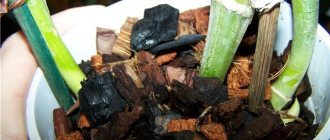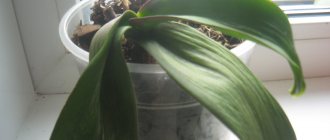The orchid's leaves are withering - what to do? The most common and easily solvable reason is improper care. If it is corrected, the plant will again be beautiful and healthy. But sometimes leaf wilting indicates more serious problems: the root system is rotting, the plant is sick or has been attacked by parasitic insects. Accordingly, other ways to solve the current situation are needed. The plant may even need to be resuscitated.
Note! First you need to determine the cause and only then begin to solve the problem so as not to worsen the situation. Remember that in most cases it is possible to save a plant, even if its root system has completely died or all its leaves have fallen off.
What is turgor?
Orchid is a very beautiful tropical flower that can be grown indoors. All gardeners want their flowers to be healthy, bloom long and have strong foliage. Unfortunately, sometimes orchid leaves become soft and limp.
Healthy orchid leaves are bright green in color and have a glossy sheen.
The normal state of the leaf blade is called turgor. Good turgor has the following characteristics:
- leaves stand straight;
- have a dense structure, not flaccid;
- elastic, not soft;
- with a slight waxy coating.
A dense and healthy leaf actively participates in the process of photosynthesis. Thanks to this, the orchid receives all the necessary nutrients.
The main reasons why leaves become soft and limp are improper care, infectious diseases and pest damage.
Why orchid leaves can become limp and soft, the main problems associated with care
The first thing that reacts to human mistakes in care is the leaves, which become soft and limp. The health of the entire plant is judged by the condition of the leaves.
Orchid leaves have become soft due to lack of watering
In overdried soil, an orchid may not only become limp and soft leaves, it may even die. However, there is no single watering schedule for this tropical crop - each specimen is unique. Therefore, before watering, it is necessary to assess the condition of the soil in the flower pot. The soil should always be slightly moist and loose.
What to do?
Immediately place the orchid and the pot in warm water for 30 minutes.
Then water as the top layer of soil dries, but not more than once a week, avoiding excess moisture.
The orchid was transfused
Leaves may become soft and limp due to excessive watering and stagnation of water in the tray of the pot. Excess moisture causes root rot. Weakened roots cannot provide adequate nutrition, the leaf plates become soft and lethargic.
What to do?
You need to check for holes for water drainage in the bottom of the flower pot. You cannot fill the orchid with water so that the container underneath is always dry. The room must be ventilated frequently.
Excess sun and overheating in orchids
The orchid is a tropical crop and loves sunlight and warmth. However, direct sunlight in hot summers, especially in the afternoon, causes great harm to it.
When there is too much sun, it is difficult to maintain optimal humidity levels. The air becomes dry, and the soil in the pot dries out - it becomes hot. In this case, the roots of the plant will lack moisture.
Another sign of overheating is that the leaves have wrinkled, become limp, soft, and drops of water are released from them. As a result, the leaf blades and peduncle will not be able to receive the necessary nutrients. Outwardly, it looks like soft and limp leaves.
What to do?
The orchid is immediately transferred to the shade and sprayed. It is very important that water does not get on the inflorescences. If you do not help the orchid in time, it will soon die. You need to closely monitor the temperature in the summer.
In winter, the roots may overheat due to heating radiators. The roots lack moisture, so the leaves become soft and limp.
ON A NOTE! A good way to help is to replant it in a double pot. The inner pot should have holes to drain excess moisture, but the outer one should not. Pebbles or expanded clay are poured into an airtight pot and a second container with a flower is inserted. Thus, after watering, water will go to the stones and evaporate. Thanks to this simple device, the roots will be moistened and will not be in danger of overheating.
Hypothermia of a flower
In winter, the pot must be positioned in such a way that cold air from the street does not reach it. A sharp drop in air temperature leads to hypothermia. Flowering stops, buds and flowers fall off, and leaves wrinkle, become soft and limp.
What to do?
Take care of the microclimate: make the room temperature comfortable and normalize the humidity level.
Orchid planted in the wrong soil
If poor-quality soil is used for planting, it becomes very compacted over time. This means that watering causes the soil to sink, and salt deposits, fungus and even mold may appear in it.
In such conditions, oxygen poorly reaches the roots of the plant, and its above-ground parts suffer. Do not clog the soil with peat and moss.
What to do?
Regularly replant and change the soil. During transplantation, all damaged tissues and processes must be removed, and the cut sites must be treated with antiseptics.
The soil is pre-disinfected with special preparations.
The products “Alirin” and “Maxim” will help to root the orchid better.
ATTENTION! It is necessary to use only high-quality substrate intended for this indoor culture.
Excessive feeding of an orchid
Flowers need moderate fertilization regularly once a month - approximately every third watering. During the flowering period, you can feed twice a month.
ON A NOTE! You need to carefully study the composition of fertilizers. For example, nitrogen activates leaf growth, but can have a bad effect on turgor pressure, making them sluggish and soft. Complex fertilizers that contain phosphorus, potassium and sodium humate are suitable for feeding orchids.
What to do?
Fertilize no more than twice a month with special preparations, for example: Bona Forte, Florovit, Agricola.
Incorrect transplant
Orchid wilting after transplantation is a common problem. However, if it continues to wither and the leaf plates become increasingly soft, this means that mistakes were made during the movement:
- the soil is chosen incorrectly;
- the acid-base balance of the soil is disturbed;
- There are no holes in the pot to drain excess moisture.
What to do?
The flower should only be replanted in a special pot with proper drainage, and the soil should be loose and consist mainly of small fractions of bark.
Main factors of wilting
Drooping foliage on an orchid is evidence of a lack of nutrients.
Droopy orchid
Other factors affecting the root system and the above-ground part of the plant can also lead to wilting.
Hypothermia
Low temperatures are typical for the winter period. If Phalaenopsis leaves begin to wither, it is recommended to check the temperature near the window. It should not fall below +15°C, otherwise the plate will lose its turgor, and the tropical plant will stop blooming and even disappear.
Overheat
Extreme heat is also harmful to orchids. Under the influence of high temperatures, water actively evaporates from the soil, and the root system suffers from moisture deficiency. The plant is forced to use its own “reserves”, sucking water from the leaves.
Insufficient watering
Indoor flowers experience a lack of moisture due to improper irrigation. Some owners water their plants after a certain period of time, not paying attention to the condition of the soil.
Frostbitten Phalaenopsis
The soil may dry out earlier due to heat, a certain looseness of the substrate, and the size of the pot.
Overmoistening
Orchids love to “drink”, but excess moisture is detrimental to the roots - it prevents air from circulating in the soil. If the substrate is dense, then the underground part becomes vulnerable to disease and may rot. As a result, the orchid's leaves wither.
Excess nutrition
Feeding is good in moderation. Phalaenopsis is sensitive to increased concentrations of active substances in the soil. Due to an excess of salts, the roots may dry out and the process will switch to the upper part of the plants.
Diseases and pests of orchids that cause leaves to wither
The condition of the leaf blades deteriorates not only due to improper care, but also due to infectious diseases and damage by insect pests.
Leaf diseases
Often, loss of turgor occurs due to a fungal or bacterial infection.
Various dark spots or white coating on withered leaves are signs of the development of diseases such as spotting, anthracnose and powdery mildew.
spotting
Spots on soft leaves can be black, yellow or orange, depending on the fungus that causes the disease.
What to do
At the first suspicion of a fungal infection, the infected specimen is isolated from other flowers and the surface where the pot stood is disinfected.
All tissue affected by the disease must be cut off and the sections treated with charcoal or an antiseptic. The entire flower is treated with Fitosporin or another suitable fungicide.
Anthracnose
The disease occurs quite often. Appears as dry light or brown spots with a yellow rim. Externally, the spots on the leaf blades may vary; they can be confused with sunburn.
What to do
Treatment is the same as for any type of spotting: isolation, pruning of flaccid leaf blades to healthy tissue, treatment with special preparations - fungicides.
Powdery mildew
The first sign of the disease is a white coating on the leaves that have become soft. Later, the tissues under the coating dry out, which can lead to the death of the plant.
What to do
It is necessary to immediately isolate the “patient”. For treatment, colloidal sulfur or the preparations “Skor” and “Topsin-M” are used.
Diseases of the root system in orchids
You need to remove the plant from the pot and inspect the roots: brown spots are a sign of rotting. The most common diseases of indoor orchids are gray, black, fusarium and brown bacterial rot.
For effective treatment, remove all damaged parts of the plant and treat with fungicides.
Orchid pests that affect leaves
Pests not only spoil the appearance of the orchid, but can also destroy it.
Most often, the leaf mass is affected by the following parasites, which make the leaves soft and lethargic:
- The whitefly is a microscopic sized butterfly. Capable of laying larvae on the roots and undersides of orchid leaves. After this, they turn yellow, become soft, then flaccid and dry out one after another.
- Aphids are dangerous pests. It quickly colonizes every part of the flower, especially on the underside of the leaf. Signs of its appearance: a white coating on the stem and leaves. Leads to deformation and twisting of the sheet plate.
- Nematodes - eat the leaf mass and make tunnels in it. Therefore, the tissues turn black and soon die.
- Thrips have a body length from 1 to 1.5 mm and two paired wings. Insect reproduction occurs in the leaf axils. They feed by eating tissue and carry pathogens of dangerous viral infections.
- Scale insects are a parasite that sticks to the leaves of a plant to feed on its juices. It reproduces actively and can lay up to 2 thousand eggs.
ON A NOTE! You can easily detect pests in water if you immerse the pot in it for a short time.
In order to quickly eliminate parasites, insecticides are used: “Fitoverm”, “Inta-Vir”, “Aktara” and others.
Ways to fight
If the orchid begins to wither, you cannot wait long its normal state to return.
Diagnostics
Examine the orchid carefully. To determine the reasons for its decline.
First of all, you need to determine the reason for the wilting of the orchid.
Even an external examination can determine the reasons. This is easy to do with transparent containers :
- What is the condition of the substrate? Is there any stagnation of water? Or it's dry. Along with the roots;
- Have any pests appeared?
- What condition are the plants in the immediate vicinity in?
- After transplanting into another container, not all orchids immediately grow. And it takes some time to get accustomed to new conditions;
- Special treatment for only purchased plants. Observe them separately for about a month.
Possible treatments
Choose reliable and effective methods. Select them as needed. Treatment must be safe for others :
- Mechanical (simple) methods : Collecting, wiping leaves, removing pests;
- Placing plants in aqueous solutions;
- Spraying the roots with running water.
Advice! Try not to replant an acquired flowering orchid.
Technology
- Carefully remove the orchid from the pot;
- Examine the roots carefully;
- Rinse the roots under running water;
- Remove rotten and dry roots;
- Treat the sections with activated carbon powder;
- Leave the orchid without substrate for two weeks;
- To prevent disease and infection, treat with a fungicide ;
- Plant your orchid in fresh (or treated) substrate. With good drainage;
- Adjust the frequency of watering and methods.
In what cases is urgent resuscitation necessary?
There should be no delay in such situations when the plant may die and resuscitation is urgently needed:
- Diseases and pests can spread very quickly. And cause great harm even in one night;
- Mechanical damage during transportation or falling plants;
- Extensive damage to roots by rot.
The orchid needs urgent resuscitation when pests appear.
The flower got stressed
Stress directly affects the condition of orchid leaves, making them lethargic. The plant gets used to certain living conditions and experiences difficulties in the process of adapting to a new place.
Examples of stressful situations: moving to a new place or frequently moving containers. In some cases, the plant recovers on its own. However, if the situation does not return to normal for a long time, then adaptation can be accelerated by creating a familiar habitat.
In addition, the orchid does not like having other tropical crops near it.
How to properly care for orchids so that the leaves do not wilt
One of the main tasks in caring for tropical flowers is to carefully monitor the condition of the leaves. To ensure that they are shiny and have good turgor, and are not flaccid and soft, you must follow the following rules:
- Watering should be done when the roots have turned gray and the condensation inside the pot has disappeared. In summer, about once every 7 days, and in winter even less often.
- Feed during flowering with fertilizers approved for orchids. They contain essential minerals, vitamins and microelements. The drugs stimulate the growth of new leaves, increase the number of ovaries and prevent chlorosis. It is important to start feeding during the active growth phase and strictly follow the instructions for use.
- Replanting can only be done in spring.
- It is necessary to keep the sheet plate clean - wipe it with a soft cloth soaked in bottled water. This way the orchid can receive enough sunlight. Add a little succinic acid to the water - 1 tablet per liter of water.
- The orchid must be in the right place where the leaf blades cannot get sunburned.
- Damaged, dried and yellowed leaves must be removed so that they do not attract pests.
- You should not apply various polishes to the leaves to make them shine, as they can cause burns.
ON A NOTE! On sale you can find sprays for caring for indoor flowers. For example, “For orchids” by Bone Forte or “Doctor Foley”. They contain vitamins and minerals. In addition, there are sprays for pest control. It is necessary to spray the leaves, but in no case should the drug come into contact with the petals during flowering, because this will ruin its appearance. Also, the treated foliage should not be exposed to direct rays of the sun - this causes chemical burns.
Answers to frequently asked questions
What conditions are necessary to prevent the leaves from becoming soft and limp?
Moderate watering, loose fertile soil, diffused sunlight and warmth.
Is it always possible to save damaged leaves?
No. In case of severe damage or frostbite, the leaf mass must be completely removed.
At what temperature should an orchid be grown?
The optimal temperature for the growth of this tropical crop is from 17° to 25°C.
Prevention
The best prevention for the development of diseases or other problems with an orchid is proper care. The Phalaenopsis orchid needs to provide:
- regular moderate watering;
- fertilization;
- high humidity (60-70%);
- high temperatures (+23-25);
- High-quality diffused lighting.
Important!
Regular inspection of the plant will help identify problems in the early stages. Particular attention is paid to the root system.
Whatever the reason for the wilting of the leaves, treatment should begin as soon as possible. The later you try to restore leaf turgor in the Phalaenopsis orchid, the longer the resuscitation process will be.











